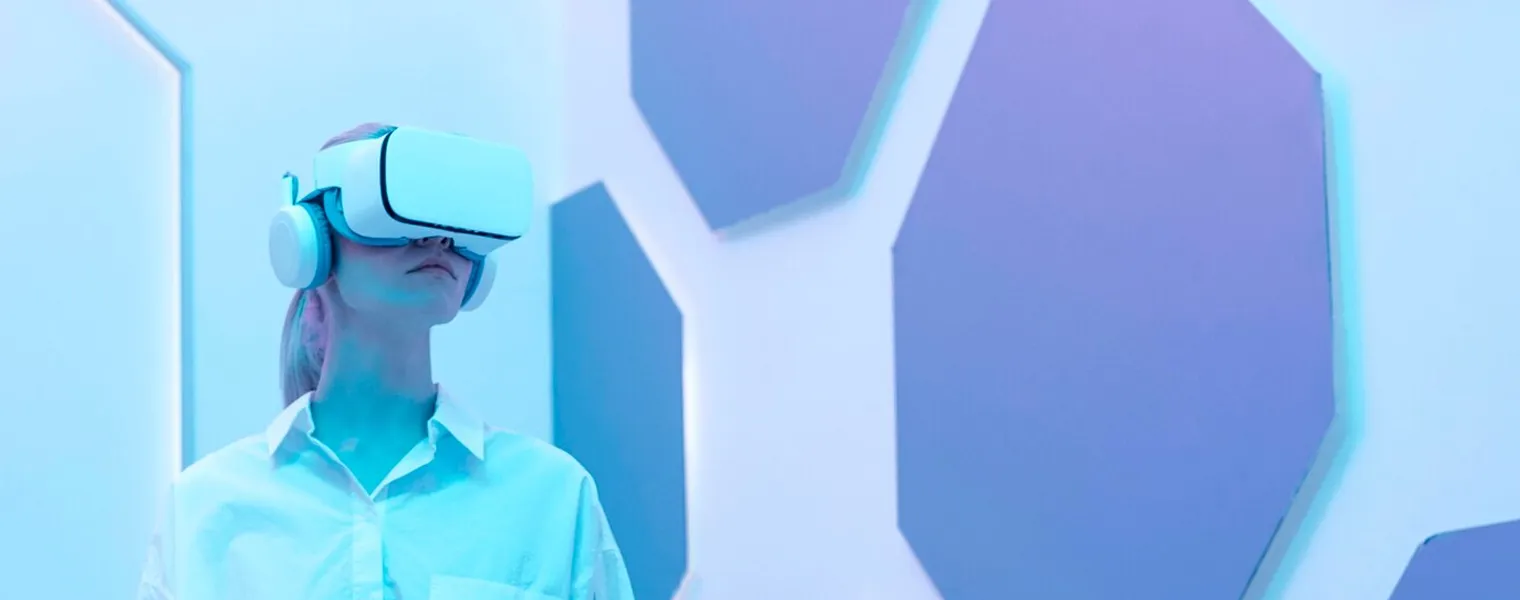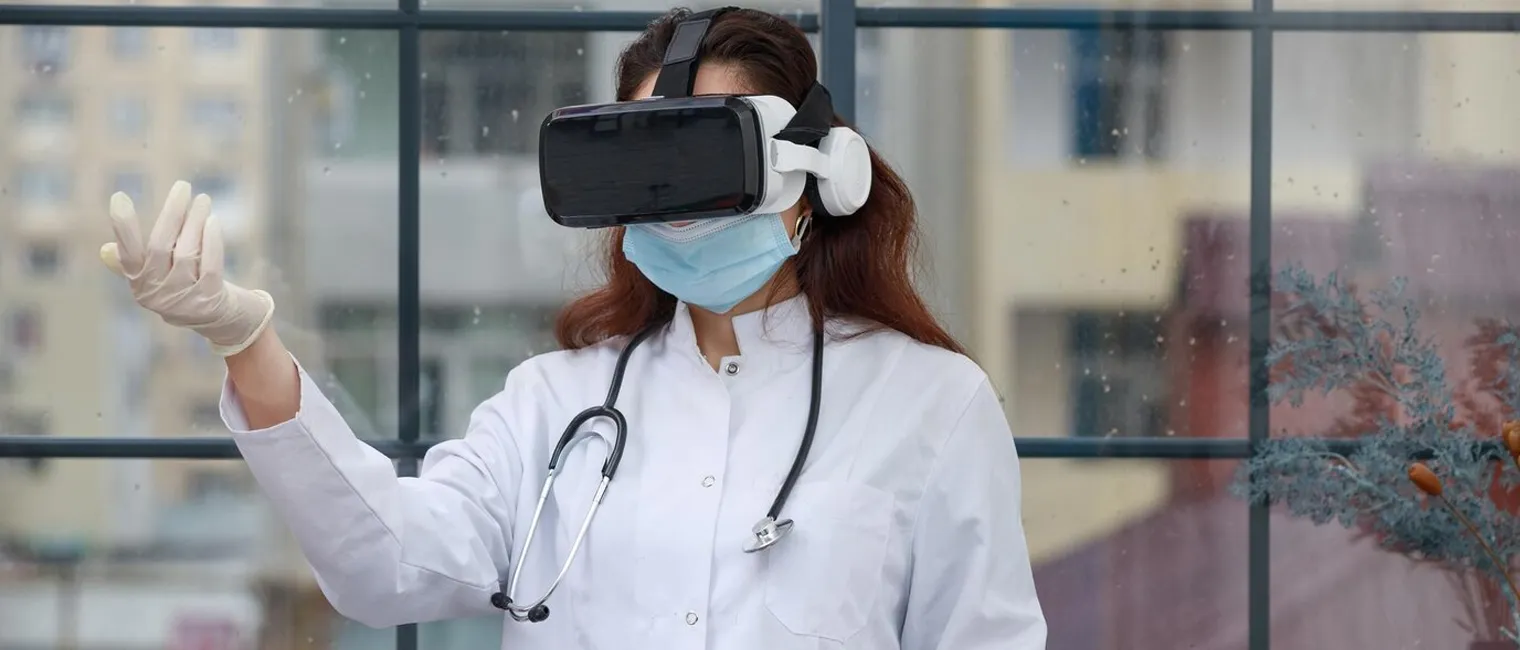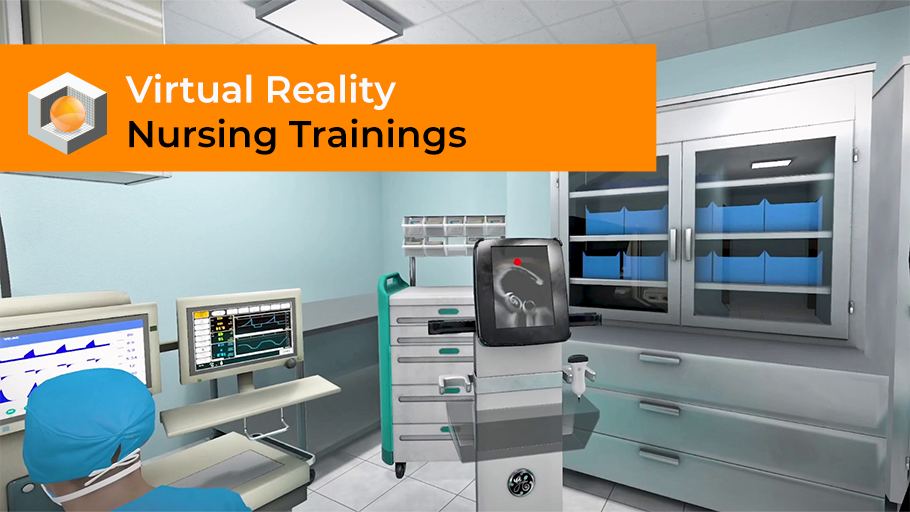VR nursing training is transforming how healthcare professionals acquire and refine their skills by providing immersive, risk-free environments for practical learning. Unlike traditional methods, VR allows nurses to engage in lifelike simulations where they can practice complex procedures, respond to critical scenarios, and enhance their technical expertise without jeopardizing patient safety. Platforms like RoT STUDIO enable the creation of highly realistic and customizable training modules, making advanced medical education more accessible and effective than ever.
VR nursing training, professionals can repeatedly perform intricate procedures such as surgical catheterization or colorectal care, gaining confidence and precision in their work. Modules like the Anatomy VR Brain Module and the Musculoskeletal System Module provide an in-depth understanding of human anatomy, offering opportunities for continuous learning and skill enhancement. These simulations bridge the gap between theoretical knowledge and real-world application, equipping healthcare teams with the tools they need to excel in their roles.
What is VR Training?
VR (Virtual Reality) training is an innovative learning method that utilizes virtual reality technology to create immersive, interactive training experiences. By transporting users into a completely virtual environment, VR training eliminates the constraints of physical locations and allows learners to practice skills and respond to scenarios that would otherwise be challenging or risky in the real world.
This training method has become increasingly popular across various industries due to its ability to:
- Provide realistic and immersive simulations.
- Enhance engagement through hands-on learning experiences.
- Minimize real-world risks during practice.
Sectors such as healthcare, safety, and education benefit significantly from VR training, as it enables learners to experiment, make mistakes, and learn without real-life consequences. For instance, a VR platform like RoT STUDIO offers tools to develop custom VR experiences for training programs without requiring coding knowledge, making it accessible to a broader audience.
What is VR in Nursing?
In the healthcare industry, particularly in nursing, VR training has revolutionized how medical professionals acquire and refine their skills. Through immersive and realistic simulations, nurses can practice complex procedures in a controlled environment, allowing for repeated attempts without risking patient safety.
Some examples of VR applications in nursing include:
- Anatomy Training: Modules such as the Anatomy VR Brain Module or the Musculoskeletal System Module allow nurses to explore and understand human anatomy in 3D detail.
- Procedural Training: Simulations for tasks like Colorectal Surgery Nursing and Surgical Catheterization Procedures provide hands-on practice for procedures that require precision and expertise.
These programs not only improve procedural accuracy but also enhance confidence and preparedness among nursing professionals. Platforms like RoT STUDIO empower healthcare institutions to develop customized training scenarios tailored to their specific needs, bridging the gap between theoretical knowledge and practical application.
Applications of VR Training in Various Sectors
VR training is not limited to healthcare. Its versatility makes it applicable in several other fields, including:
- Health, Safety & Environment (HSE): Programs such as HSE Risk Hunt and Working at Height help employees identify potential hazards and practice safety protocols in lifelike virtual environments.
- Education: VR enables interactive learning experiences for students, making complex subjects like science and history more engaging.
- Automotive Design: Engineers and designers can prototype new vehicles in virtual environments, reducing the cost and time associated with physical prototyping.
- Mining Industry: Simulations like Underground Mining Risk Hunt prepare workers for challenging and hazardous environments, ensuring they are well-trained for on-site operations.
Why Choose RoT STUDIO for VR Training?
RoT STUDIO simplifies the creation of virtual reality content by offering an intuitive, drag-and-drop interface. Designed for users without coding or technical expertise, it provides all the necessary tools to build VR experiences tailored to specific training needs.
Key advantages of RoT STUDIO include:
- Ease of Use: A user-friendly interface ensures that even non-technical users can design VR scenarios.
- Customization: The platform supports a wide range of industries, allowing businesses to create unique training solutions.
- Collaboration: RoT STUDIO breaks geographical barriers, enabling teams to collaborate and learn together in virtual spaces.
By leveraging the capabilities of RoT STUDIO, organizations can innovate their training programs and achieve better outcomes while reducing costs and risks.

Who Uses VR Training?
VR (Virtual Reality) training is a transformative tool used by a wide range of industries and professionals who aim to enhance learning outcomes, improve safety, and increase operational efficiency. By creating immersive and interactive environments, VR training offers practical, hands-on experiences that traditional methods cannot match. The following sectors and professionals leverage VR training extensively:
- Healthcare Professionals
Healthcare is one of the primary industries adopting VR training to improve skills, reduce risks, and enhance patient care. For example:
- Surgeons and Nurses: Modules such as the Anatomy VR Brain Module and Surgical Catheterization Procedure allow healthcare professionals to practice complex medical procedures without risking patient safety.
- Nursing Staff: Training programs like Colorectal Surgery Nursing prepare nurses for intricate procedures, enabling them to gain confidence and accuracy in a controlled environment.
By using platforms like RoT STUDIO, healthcare institutions can develop tailored VR modules to address their unique training needs, fostering better outcomes and greater preparedness among their teams.
- Safety and Risk Management Teams
Industries with high-risk environments, such as construction, mining, and manufacturing, rely on VR training to ensure worker safety and regulatory compliance. Some key examples include:
- Risk Management Specialists: Programs like HSE Risk Hunt and Working at Height simulate hazardous scenarios, enabling workers to identify risks and practice emergency responses in a safe setting.
- Disaster Preparedness Teams: Simulations such as Earthquake Risk Hunt and Underground Mining Risk Hunt allow teams to rehearse critical procedures for disaster scenarios without endangering lives.
Using VR, these teams can train extensively in virtual environments, mitigating the risks of real-world training while improving preparedness and efficiency.
- Educators and Trainers
Educational institutions and training organizations leverage VR to create engaging and interactive learning experiences for students and trainees. Examples include:
- Interactive Classrooms: VR platforms transform abstract concepts into tangible experiences, such as virtual chemistry labs or historical recreations.
- Skill-Based Training: Trainees can practice tasks, such as vehicle repair or technical equipment handling, in a controlled environment, enabling them to learn through trial and error.
- Automotive Designers and Engineers
The automotive industry benefits significantly from VR training, particularly in the design and prototyping phases. VR allows engineers and designers to:
- Visualize and test new vehicle designs.
- Identify potential issues early in the development process.
- Reduce costs and time associated with physical prototyping.
- Corporate Teams
Corporate organizations utilize VR training for employee development and collaboration. Key areas include:
- Onboarding and Soft Skills Training: New employees can familiarize themselves with their roles and organizational culture through immersive VR experiences.
- Team Collaboration: Platforms like RoT STUDIO enable remote teams to collaborate in shared virtual spaces, breaking down geographical barriers and enhancing productivity.

What Does VR Therapy Do?
VR therapy, or virtual reality therapy, leverages immersive technology to address various psychological, physical, and emotional challenges in a controlled and engaging environment. By simulating real-world or imaginative scenarios, VR therapy creates opportunities for individuals to confront fears, practice new skills, or undergo rehabilitation without the risks or limitations of traditional methods.
- Psychological and Behavioral Therapy
One of the primary applications of VR therapy is in treating psychological conditions. Through virtual environments, therapists can guide individuals to safely experience and manage triggers or challenging situations. For example:
- Exposure Therapy: VR enables patients to face fears like heights, public speaking, or social anxiety in a controlled environment. Gradual exposure reduces fear responses over time.
- PTSD Treatment: Veterans and trauma survivors can reframe their memories in a safe space, aided by realistic yet controlled simulations.
- Cognitive Behavioral Interventions: Therapists use VR to recreate scenarios for role-playing or practicing coping mechanisms.
The adaptability of platforms like RoT STUDIO allows therapists to design customized simulations tailored to individual needs, making therapy more effective and patient-specific.
- Physical Rehabilitation and Motor Skills Development
VR therapy is revolutionizing physical rehabilitation by offering patients interactive exercises that promote recovery and build motor skills. Virtual tasks can be tailored to individual progress levels, ensuring a balance of challenge and achievability. Key examples include:
- Stroke Rehabilitation: Patients can practice arm and hand movements in a virtual environment that rewards their efforts with visual and auditory feedback.
- Injury Recovery: VR games and simulations make repetitive exercises more engaging, improving compliance and motivation during recovery.
- Motor Skills Training: Virtual tools help individuals regain precision and coordination after accidents or neurological disorders.
Platforms like RoT STUDIO support healthcare professionals in creating personalized therapy sessions, helping patients recover with tools that are both functional and enjoyable.
- Pain Management
Virtual reality has also shown promise in alleviating pain, both chronic and acute. Immersive experiences distract patients from discomfort, reducing their reliance on medication. For instance:
- Burn Recovery: Patients undergoing painful dressing changes can immerse themselves in soothing virtual worlds, significantly reducing their perception of pain.
- Chronic Pain Relief: Mindfulness and relaxation exercises in VR environments help patients manage conditions like arthritis or fibromyalgia.
- Cognitive and Social Skill Training
VR therapy is highly effective for individuals with developmental disorders or social challenges. By simulating everyday scenarios, it allows users to practice communication, decision-making, and problem-solving in a safe space. Examples include:
- Autism Therapy: Virtual classrooms or workplaces help individuals with autism spectrum disorder (ASD) practice navigating social interactions.
- Dementia Care: VR stimulates memory and cognitive functions, enhancing the quality of life for individuals with dementia.
Why is VR Therapy Unique?
The ability to create highly customizable and engaging simulations is what sets VR therapy apart from traditional methods. RoT STUDIO plays a crucial role in this by empowering professionals to design tailored virtual environments without requiring coding expertise. Its drag-and-drop interface simplifies the development of therapy programs, ensuring that every scenario meets specific therapeutic goals. This flexibility not only enhances the patient experience but also expands the scope of therapy to address diverse challenges effectively.
VR therapy continues to push boundaries in healthcare and beyond, offering innovative, accessible, and impactful solutions for improving mental, physical, and emotional well-being. This evolution of technology in therapy underscores the transformative potential of virtual reality in shaping the future of care.
Why is VR Effective?
Virtual Reality (VR) has emerged as a groundbreaking tool in various industries due to its unique ability to create immersive, interactive, and realistic environments. Here are the primary reasons why VR is highly effective:
- Immersive Learning Environments
VR enables users to experience lifelike scenarios, allowing for better understanding and retention of information. Unlike traditional training or education methods, VR immerses individuals in a 360-degree environment where they can interact with virtual objects and surroundings.
- Healthcare Training: Modules like Anatomy VR Brain Module and Colorectal Surgery Nursing enable medical professionals to practice complex procedures in a safe, controlled environment.
- Risk-Free Practice: VR allows users to make mistakes without real-world consequences, fostering better learning outcomes.
- Enhanced Engagement and Focus
Traditional learning methods often fail to fully capture a user’s attention. VR, however, eliminates distractions by immersing the user entirely in the experience. This results in higher levels of engagement and focus, making VR particularly effective in training and education.
- In sectors like Health, Safety, and Environment (HSE), VR scenarios such as Earthquake Risk Hunt or Underground Mining Risk Hunt ensure employees stay engaged while learning life-saving protocols.
- VR simulations maintain interest by offering interactive and dynamic content, motivating users to actively participate rather than passively observe.
- Real-Time Feedback and Customization
VR provides immediate feedback to users, helping them identify areas for improvement and adjust their approach. Platforms like RoT STUDIO allow for the customization of training modules to meet specific learning objectives, ensuring content is always relevant.
- In corporate training, teams can practice soft skills such as public speaking or team collaboration and receive actionable feedback through analytics built into VR systems.
- Custom VR modules can be tailored to an organization’s unique needs, ensuring targeted skill development.
- Cost and Time Efficiency
Implementing VR reduces the need for physical resources, travel, and extensive human supervision, making it a cost-effective solution for many industries. For example:
- Automotive Prototyping: Engineers can design and test new vehicle models in a virtual environment, significantly reducing the costs associated with physical prototypes.
- Global Collaboration: Platforms like RoT STUDIO allow teams from different locations to collaborate in a virtual space, saving time and travel expenses.
- Safe Simulation of High-Risk Scenarios
VR is unparalleled in its ability to recreate high-risk scenarios without exposing users to actual danger. This makes it invaluable in fields like healthcare, construction, and disaster management.
- Scenarios such as Working at Height or LoTo Lock Training help employees practice safety protocols in a controlled environment.
- Medical professionals can prepare for emergency procedures, such as surgical interventions, without risking patient safety.
- Scalability Across Industries
VR’s versatility makes it effective across diverse sectors, from education to automotive design. Using platforms like RoT STUDIO, organizations can create tailored VR experiences that address specific challenges, regardless of industry.
- Education: VR transforms traditional classrooms by offering interactive lessons, such as virtual lab experiments or historical site tours.
- Corporate Training: Teams can practice real-world scenarios in areas such as negotiation, conflict resolution, or customer service, ensuring they are well-prepared for actual situations.

